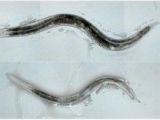The brain is our main sexual organ. It controls everything: from sex drive and pleasure to sexual orientation. Now a team at the University of Utah has even managed to induce homosexuality! Not in humans, but in nematode worms. "They look like girls, but act and think like boys. The [same-sex attraction] behavior is part of the nervous system." said first author Jamie White, a postdoctoral researcher.
"The conclusion is that sexual attraction is wired into brain circuits common to both sexes of worms, and is not caused solely by extra nerve cells added to the male or female brain," said lead researcher Professor Erik Jorgensen, scientific director of the Brain Institute at the University of Utah and an investigator with the Howard Hughes Medical Institute.
"The reason males and females behave differently is that the same nerve cells have been rewired to alter sexual preference. An evolutionary biologist will consider this to be a potentially common mechanism for sexual attraction. We cannot say what this means for human sexual orientation, but it raises the possibility that sexual preference is wired in the brain. It seems possible that if sexual orientation is genetically wired in worms, it would be in people too. Humans have free will, so the picture is more complicated in people." said Jorgensen.
The research was made on the nematode species C. elegans, 1 mm long, living in the soil and feeding on bacteria. These worms are blind, being attracted towards each other through smell. Most individuals are hermaphrodites and just one in 500 individuals is male. Hermaphrodites have both male and female genitalia, but the team referred to them as "females" because they deliver offspring.
"A hermaphrodite makes both eggs and sperm. She doesn't need to mate [with a male] to have progeny, but can fertilize her own eggs. Most of the time, the hermaphrodites do not mate. But if they mate, instead of having 200 progeny, they can have 1,200 progeny." said Jorgensen.
"C. elegans are few and far between in soil. So natural selection favored hermaphroditic worms because when they found an abundant food source, they were able to feast and make babies even if no males were nearby," he explained.
Male nematodes detect the hermaphrodites by smelling the chemicals they emit (pheromones). The team investigated three possibilities for this male attraction to hermaphrodites (nematode's body is formed by about 1,000 cells): 4 extra smell-related (CEM) neurons encountered just in male brains, which develop during the "puberty"; 4 basic smell-related neurons (2 AWC and 2 AWA) encountered in both males and hermaphrodites and finally, both the accessory and core neurons. Male attraction was linked to the third variant.
"We thought the extra CEM neurons provided sexual preference because teen males are not attracted to hermaphrodites but adult males are. We found instead that the brain - which is the same in young males and hermaphrodites - is rewired during the worm equivalent of puberty to make the males attracted to hermaphrodites. What we show is that the shared nervous system [common between male and hermaphrodite] is broadly sexualized, and sexual attraction can be changed by essentially flipping a genetic switch in that common brain," said Jorgensen.
The team destroyed by laser microsurgery the CEM neurons in male larvae males, but these adult males were still "straight". This meant that the core neurons experience a sexualization and the CEM neurons do not control male's sexuality, even if they are involved in it.
The team also eliminated the 8 types of neurons linked to smell and taste (CEM, AWA and AWC). Their elimination affected the males' sexual attraction. But if the neurons were destroyed at puberty, the male larvae developed into adults attracted by "females". "The nervous system can compensate for lost neurons as it goes through puberty," said Jorgensen.
"Why would an organism that has only 383 nerve cells use eight of them for sexual attraction? It must be that the behavior is very important. There is redundancy. The system is flexible." said White.
Further on, "we took the hermaphrodite brain and we activated the genes that determine maleness, but only in the brain and not in the rest of the worm," said Jorgensen. When the brains of the hermaphrodites were masculinized, by activating the fem-3 gene, these individuals "were attracted to other hermaphrodites."
This means sexual orientation is determined by brain development in both sexes.
The fem-3 gene induces the development of the male's body, like the tail used for copulation. Because the gene was turned on specifically in the brain, the hermaphrodites developed normal hermaphrodite body and they just switched sexual behavior.
The team washed the hermaphrodites and some of this water, filled with pheromones, was put in a growth medium. Males moved toward the pheromone-filled wash water, neglecting the hermaphrodites. The engineered hermaphrodites were also attracted by the hermaphrodite pheromones.
"People debate whether the brain is influenced by sexual hormones from the gonads or whether the behavior is derived from the brain alone. In this case, it's clear the brain is sexualized. ? The surprise was that sensory neurons found in the hermaphrodite brain are involved in sexual attraction in males." said Jorgensen.

 14 DAY TRIAL //
14 DAY TRIAL // 
